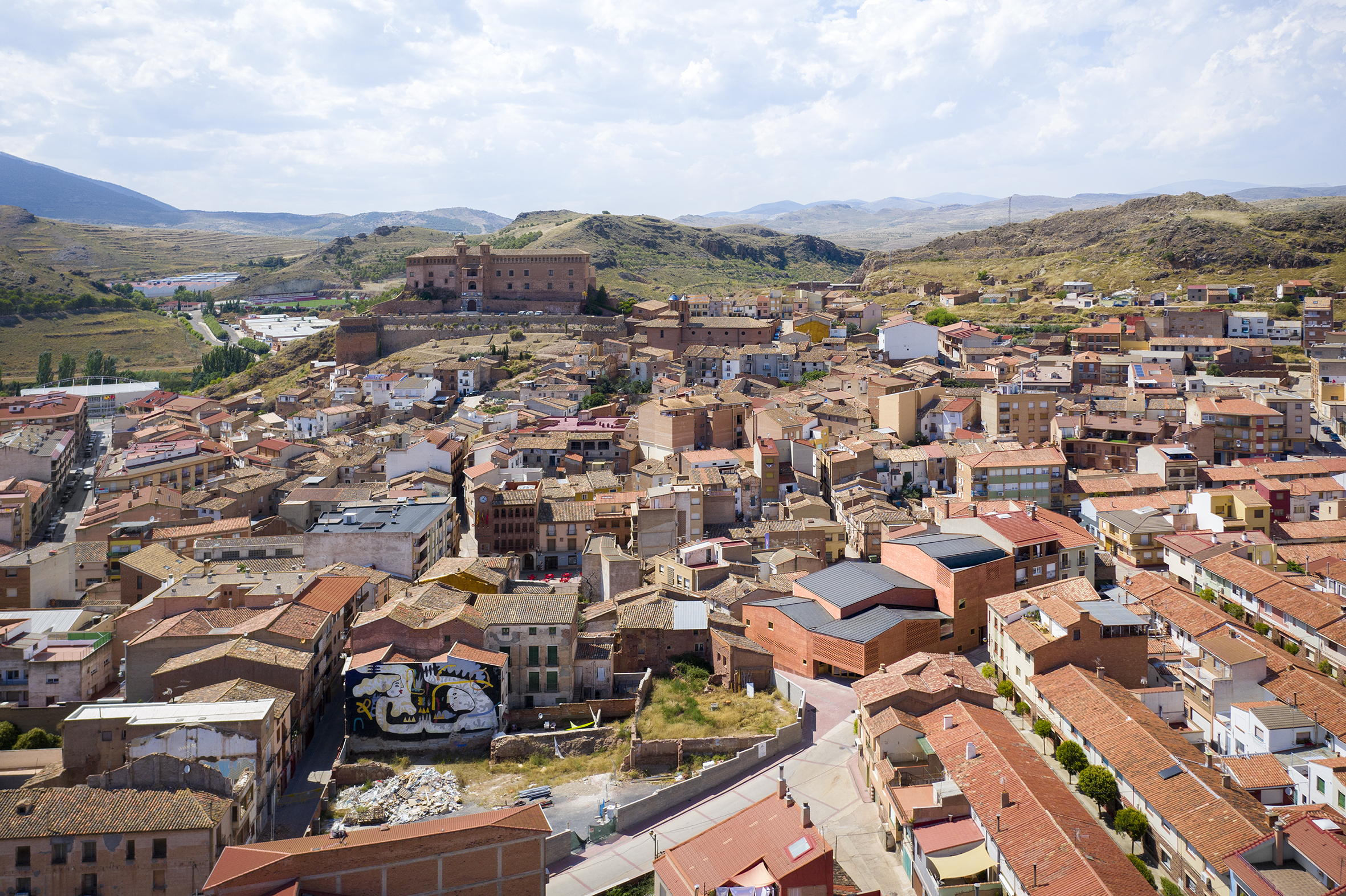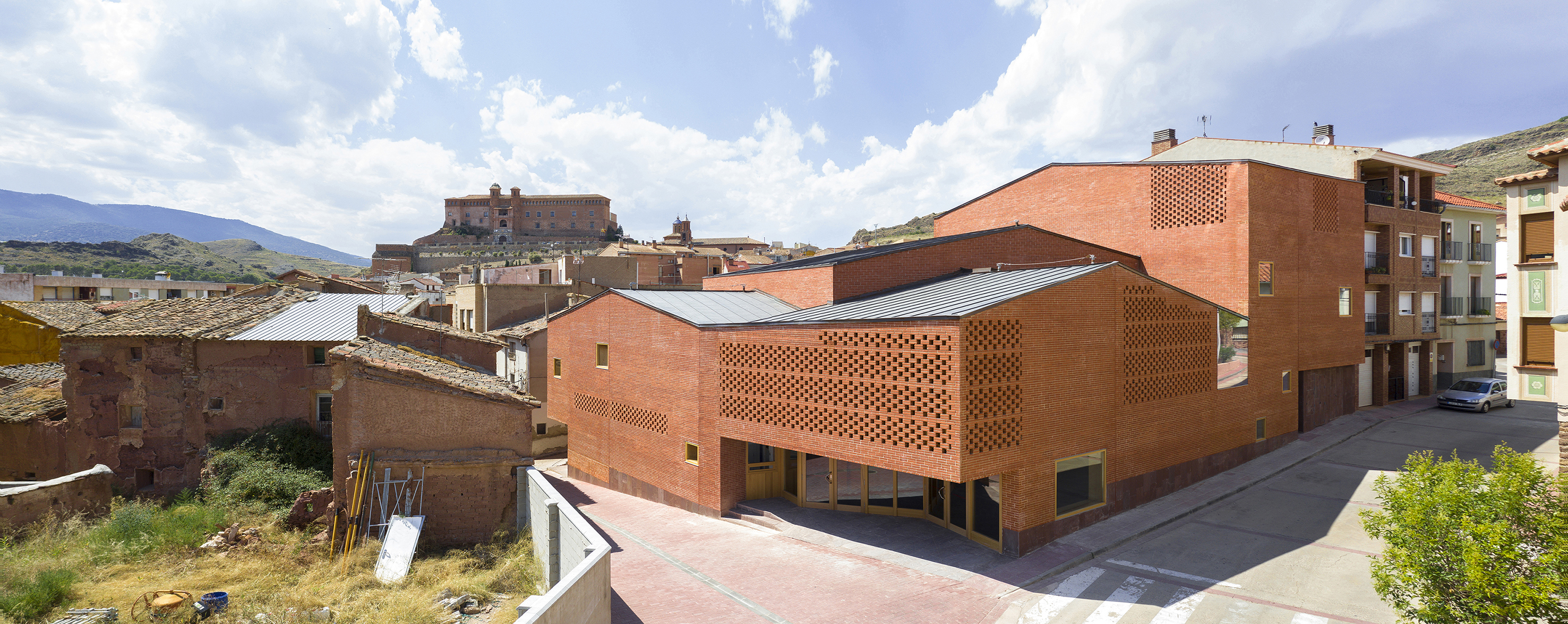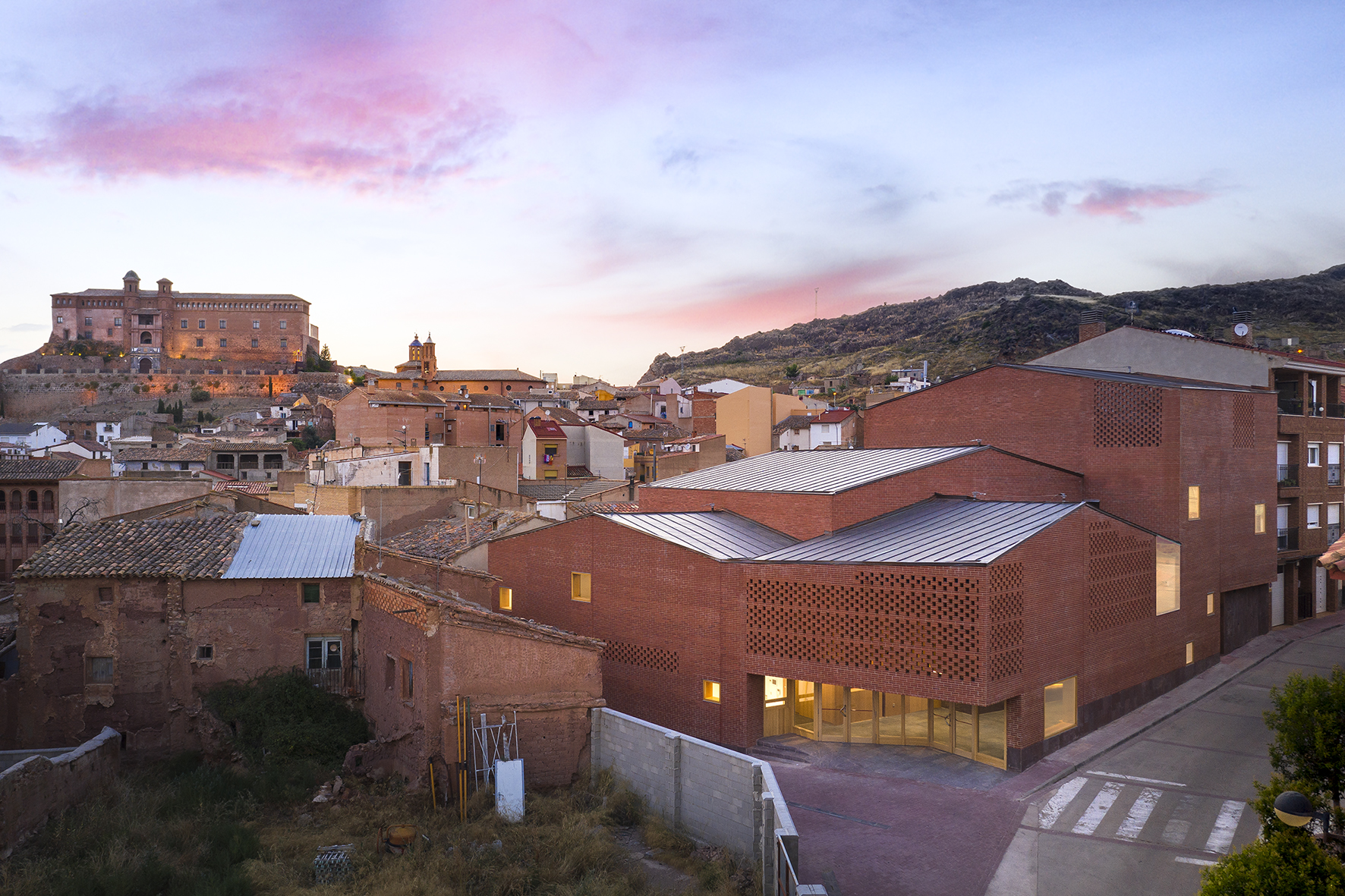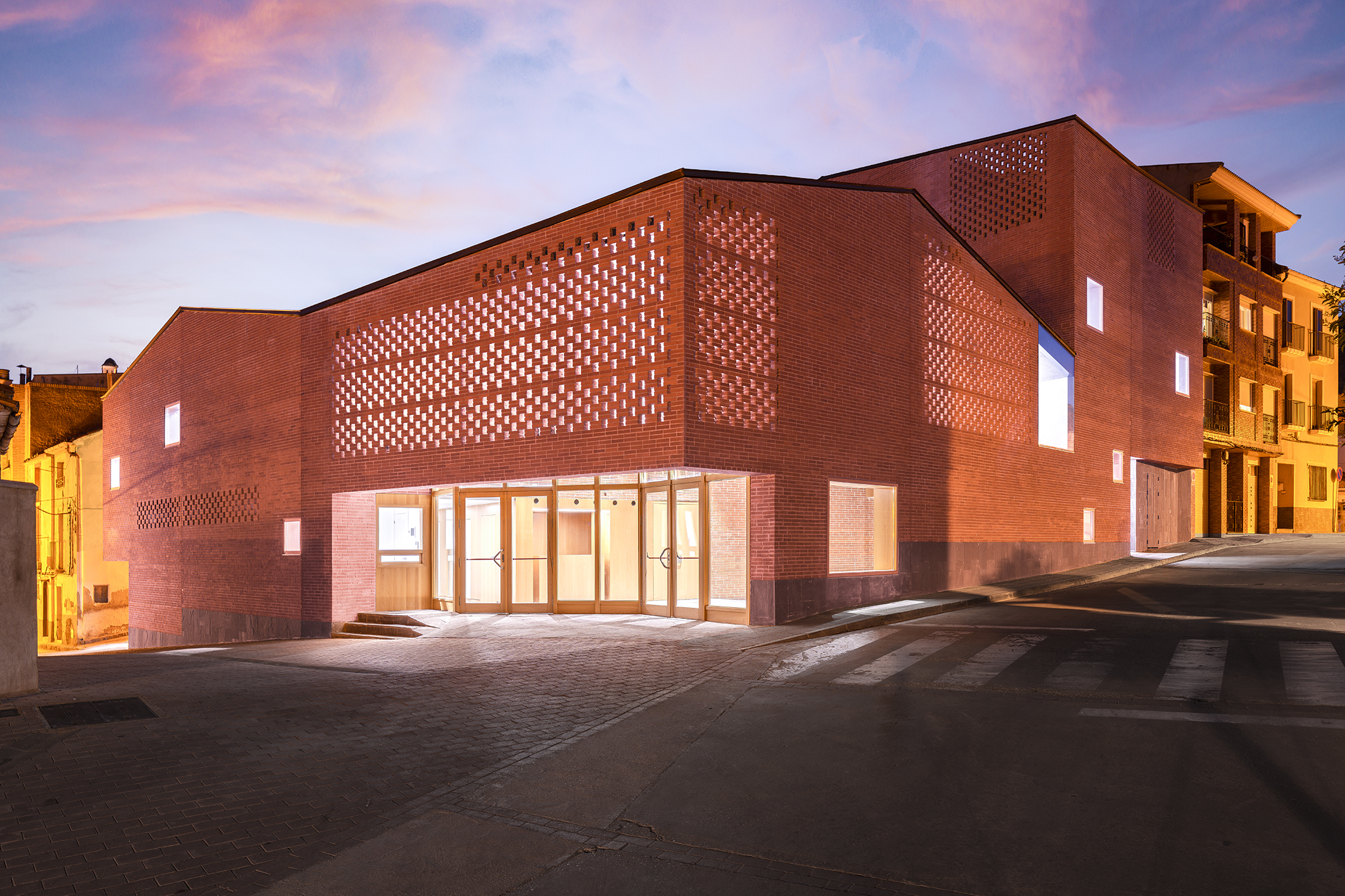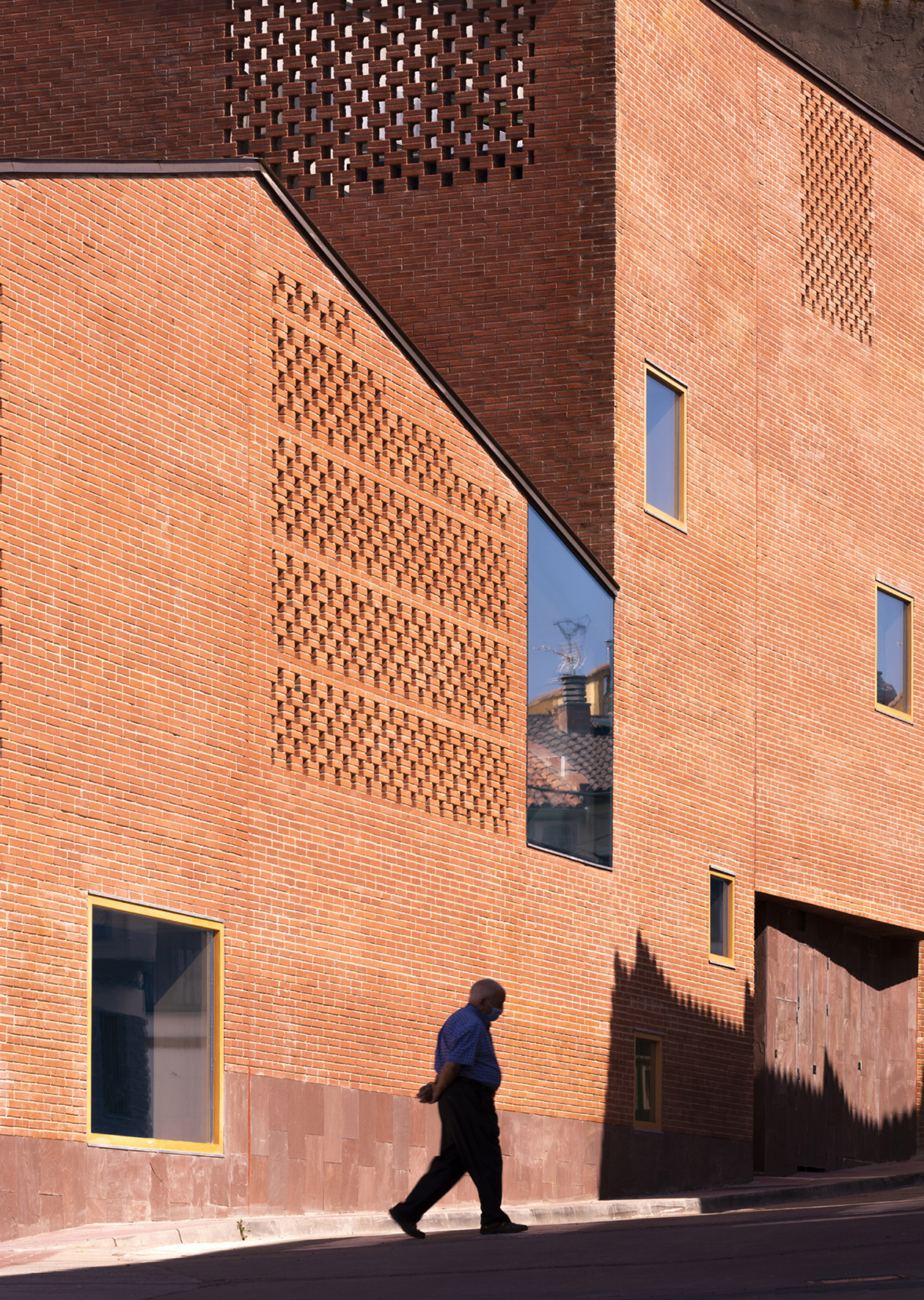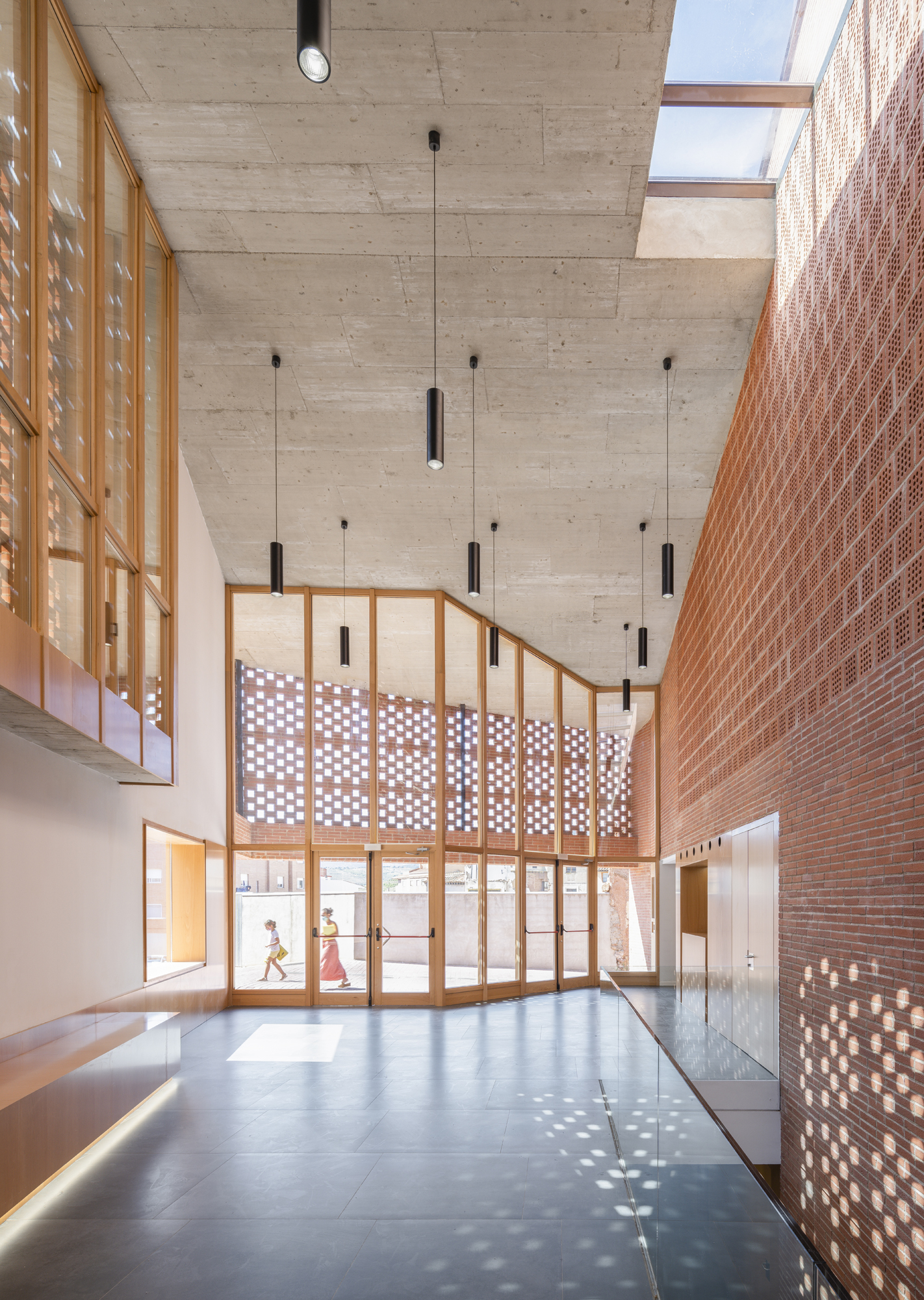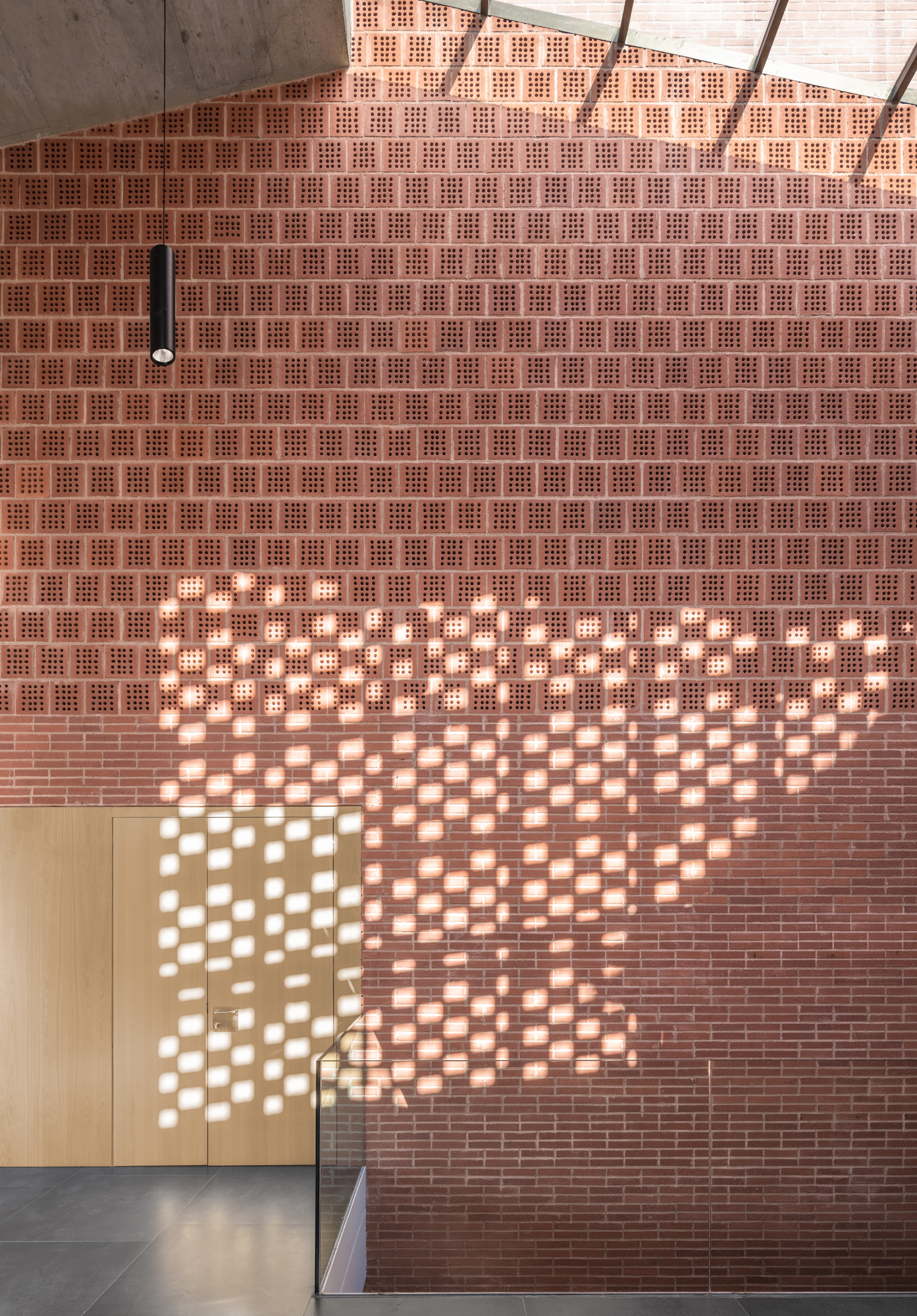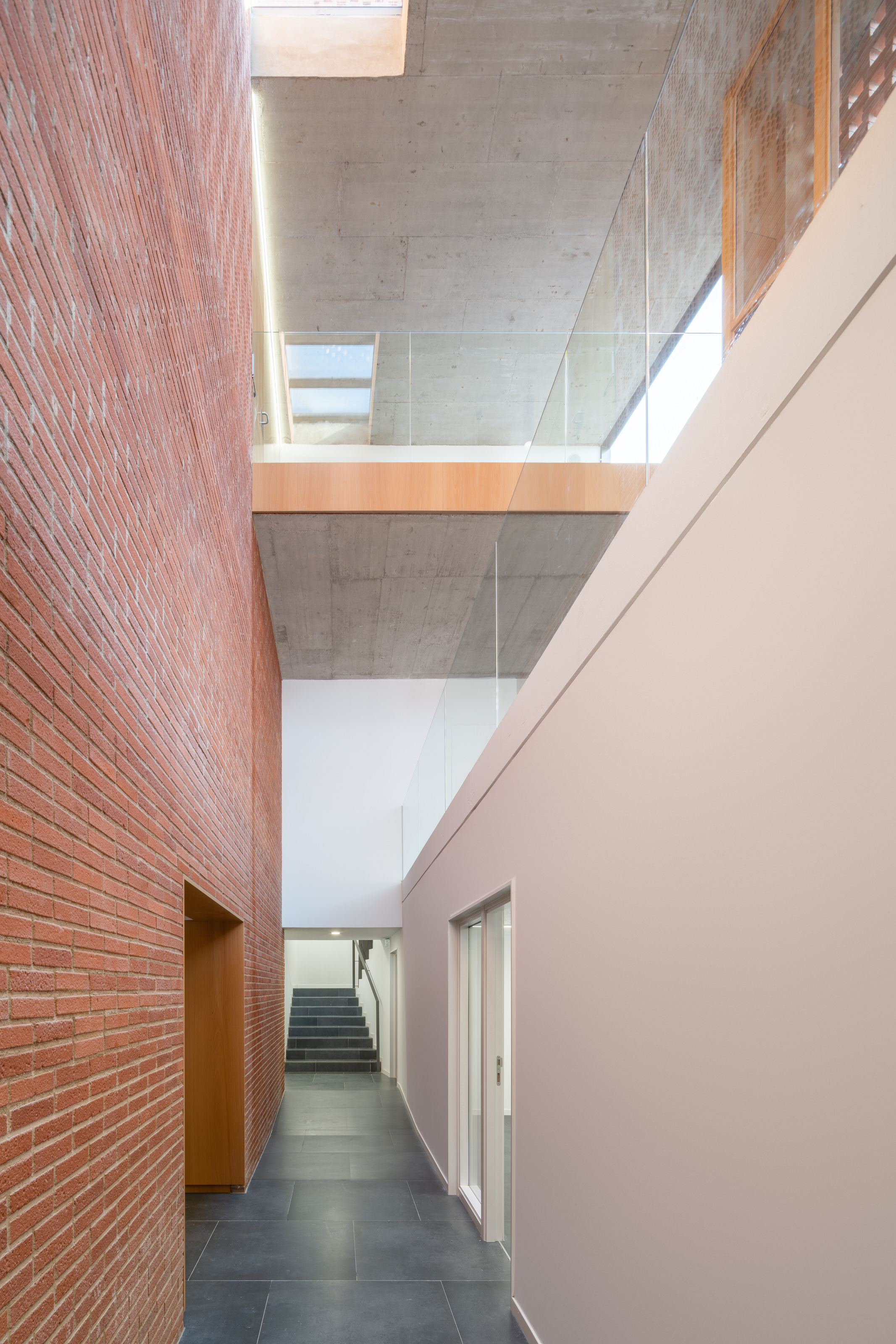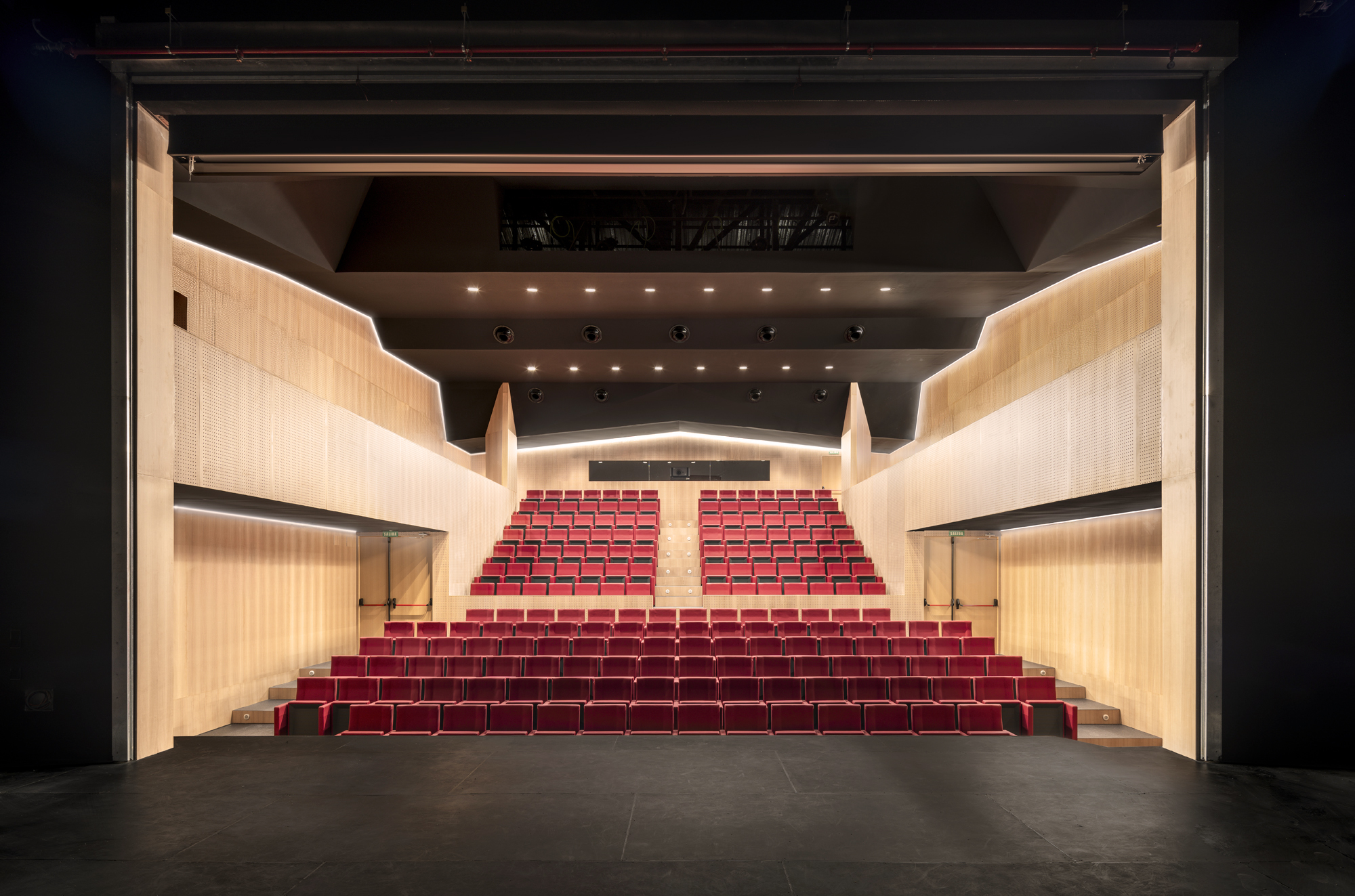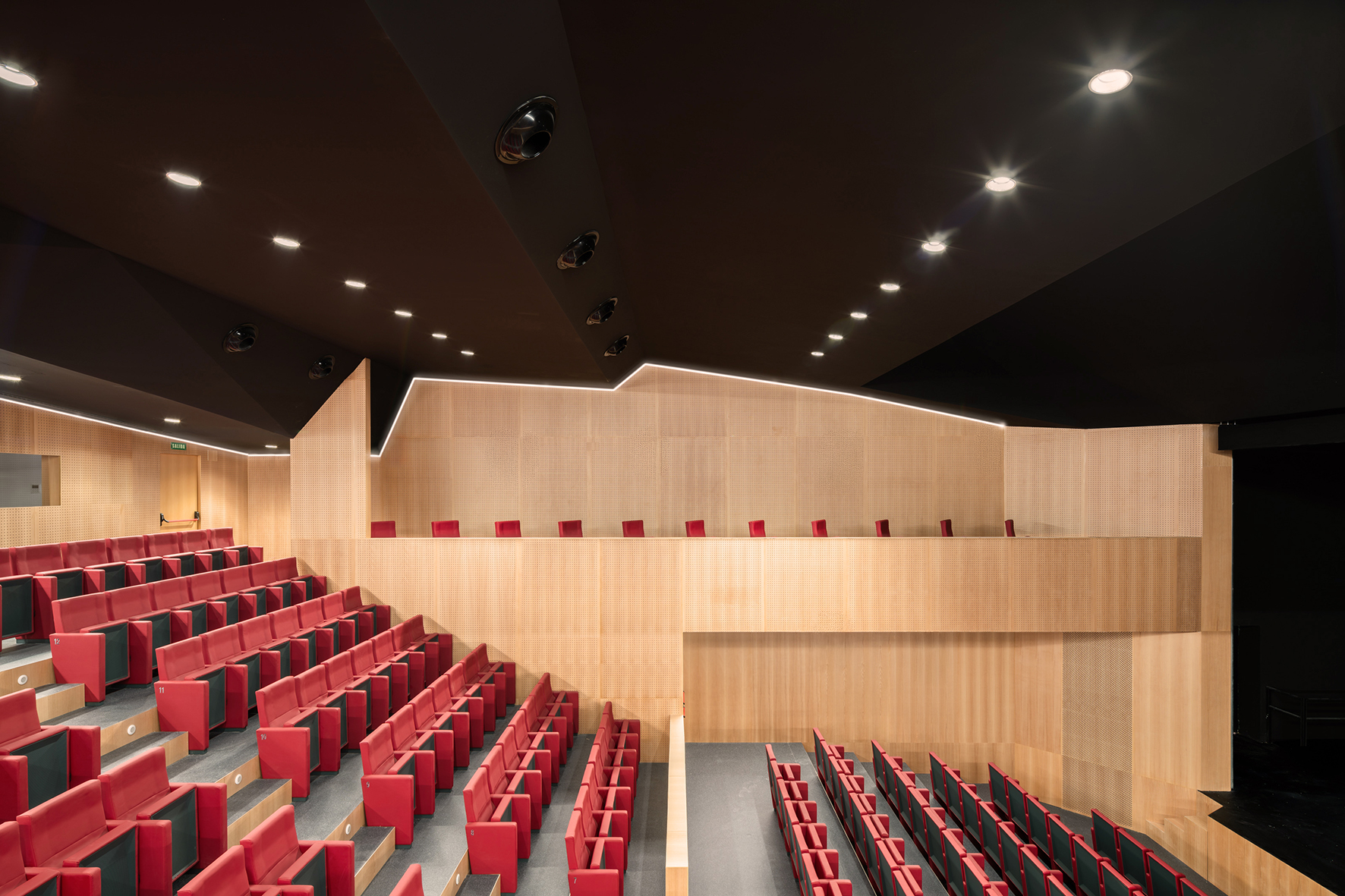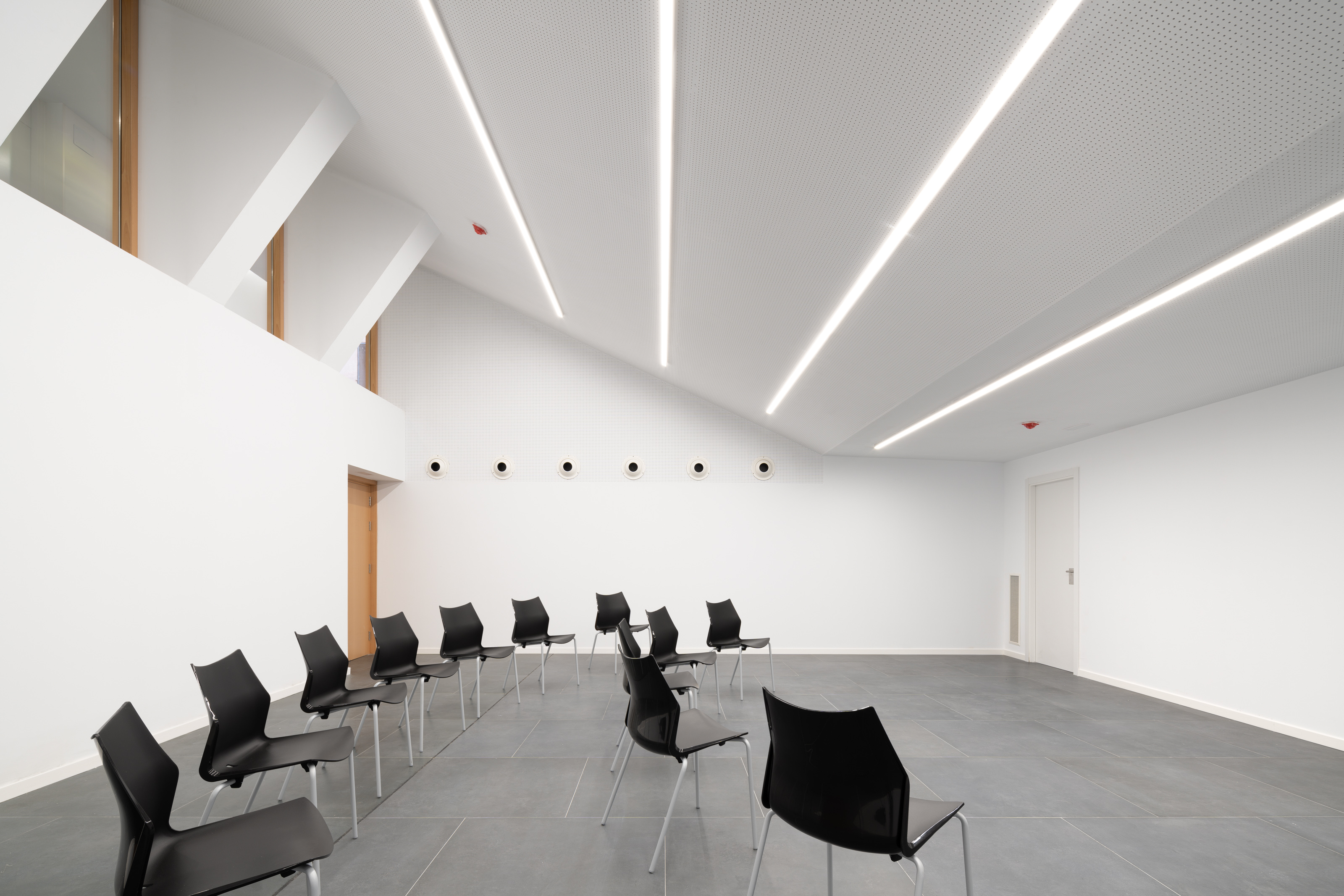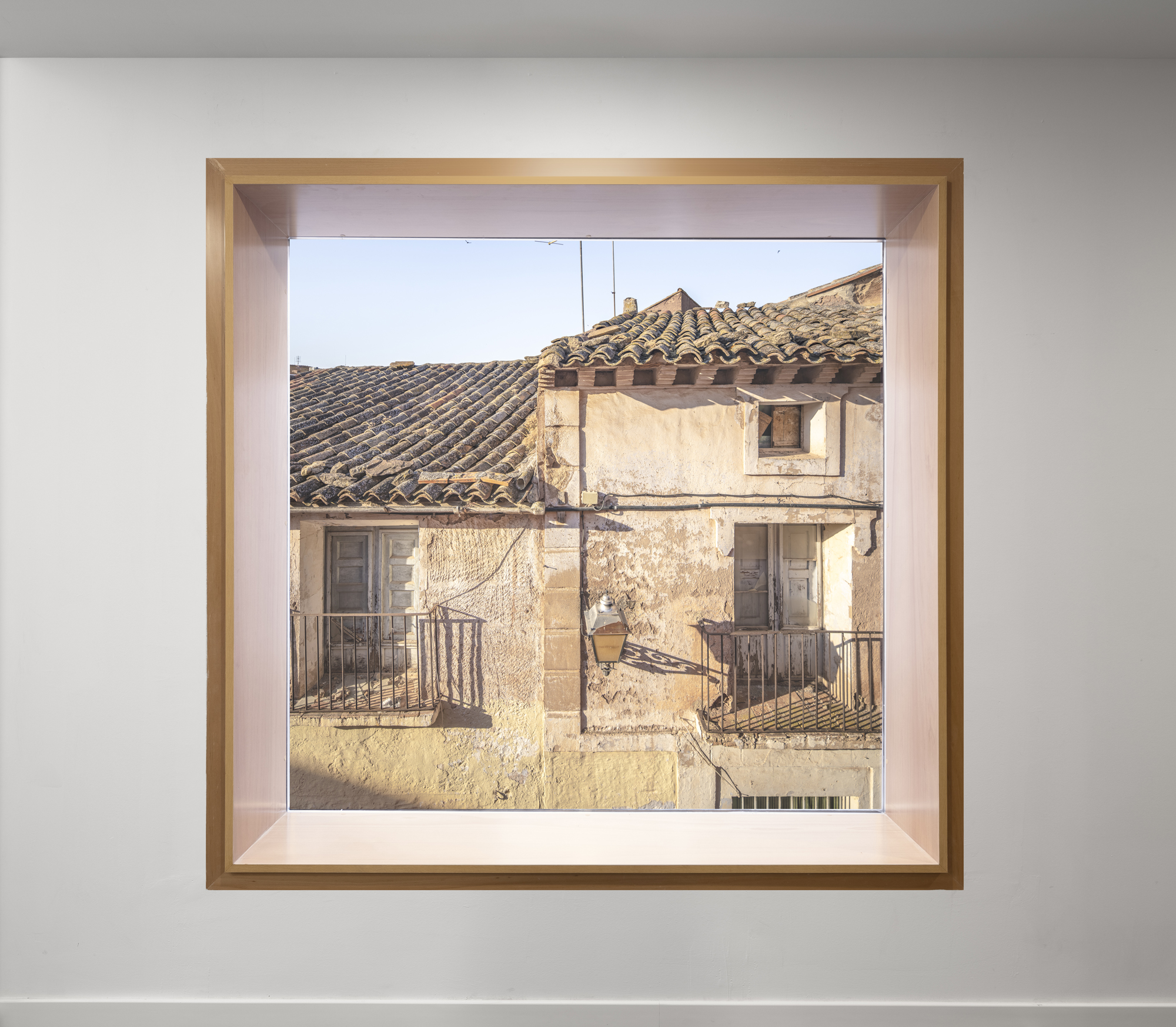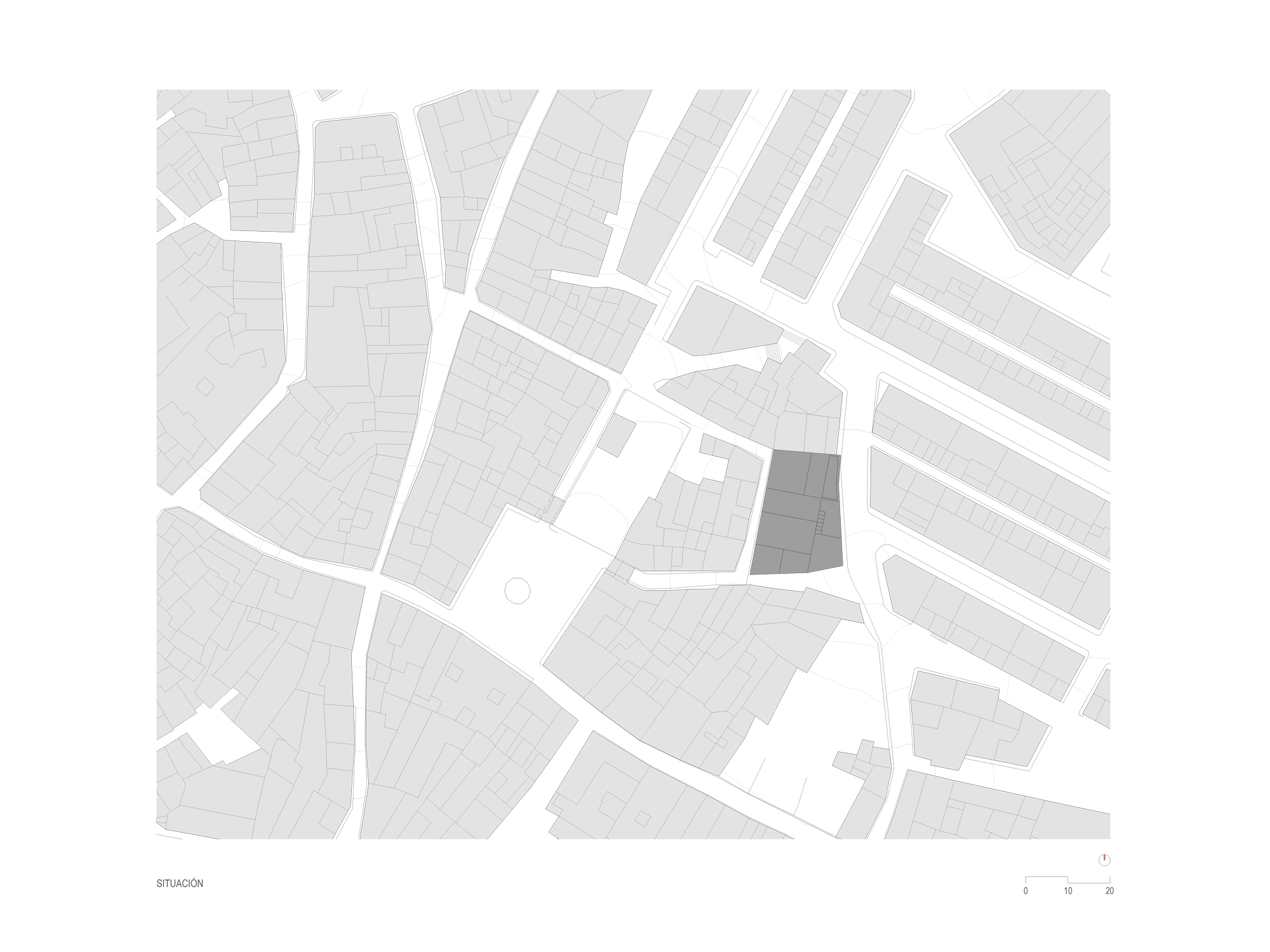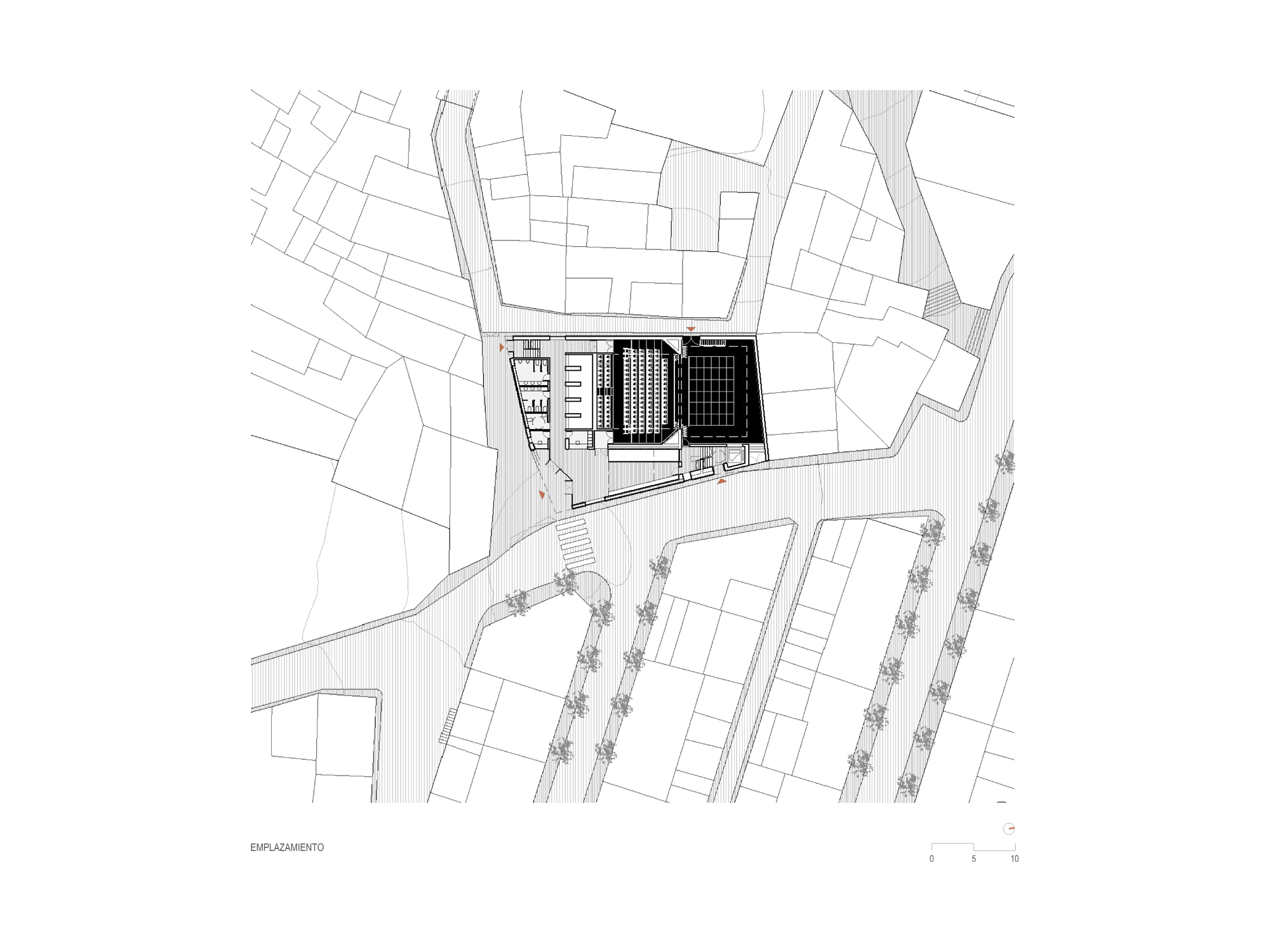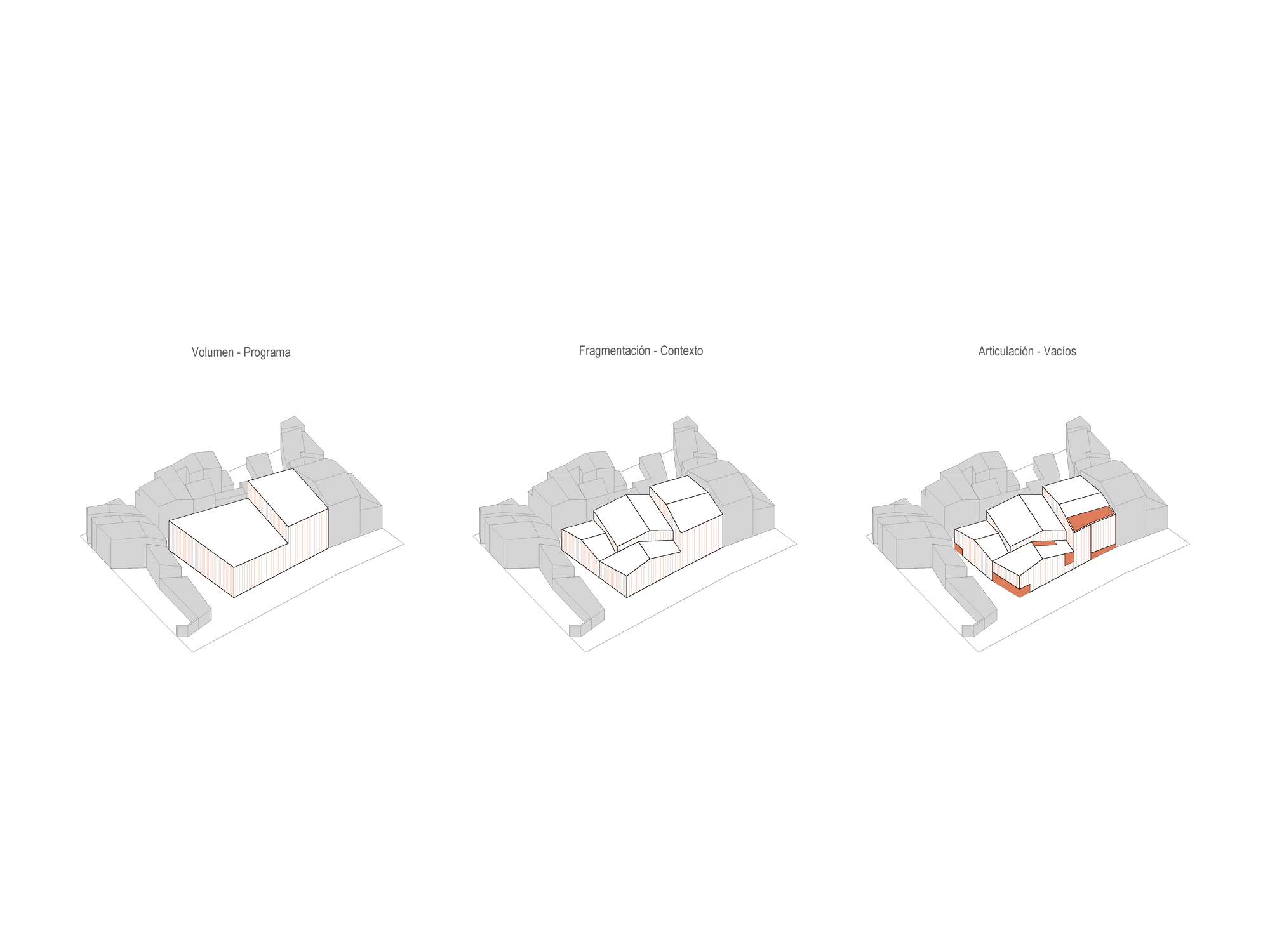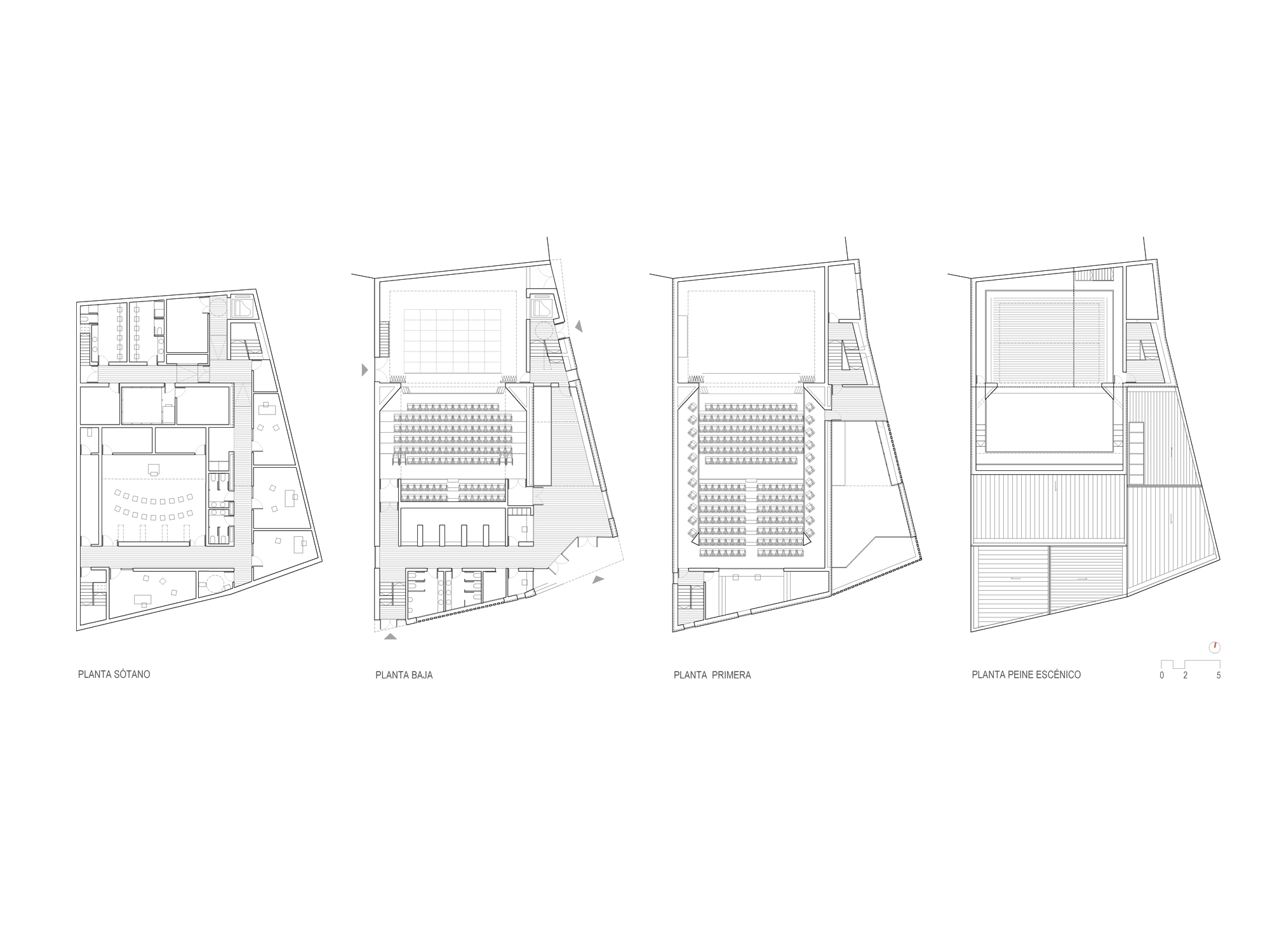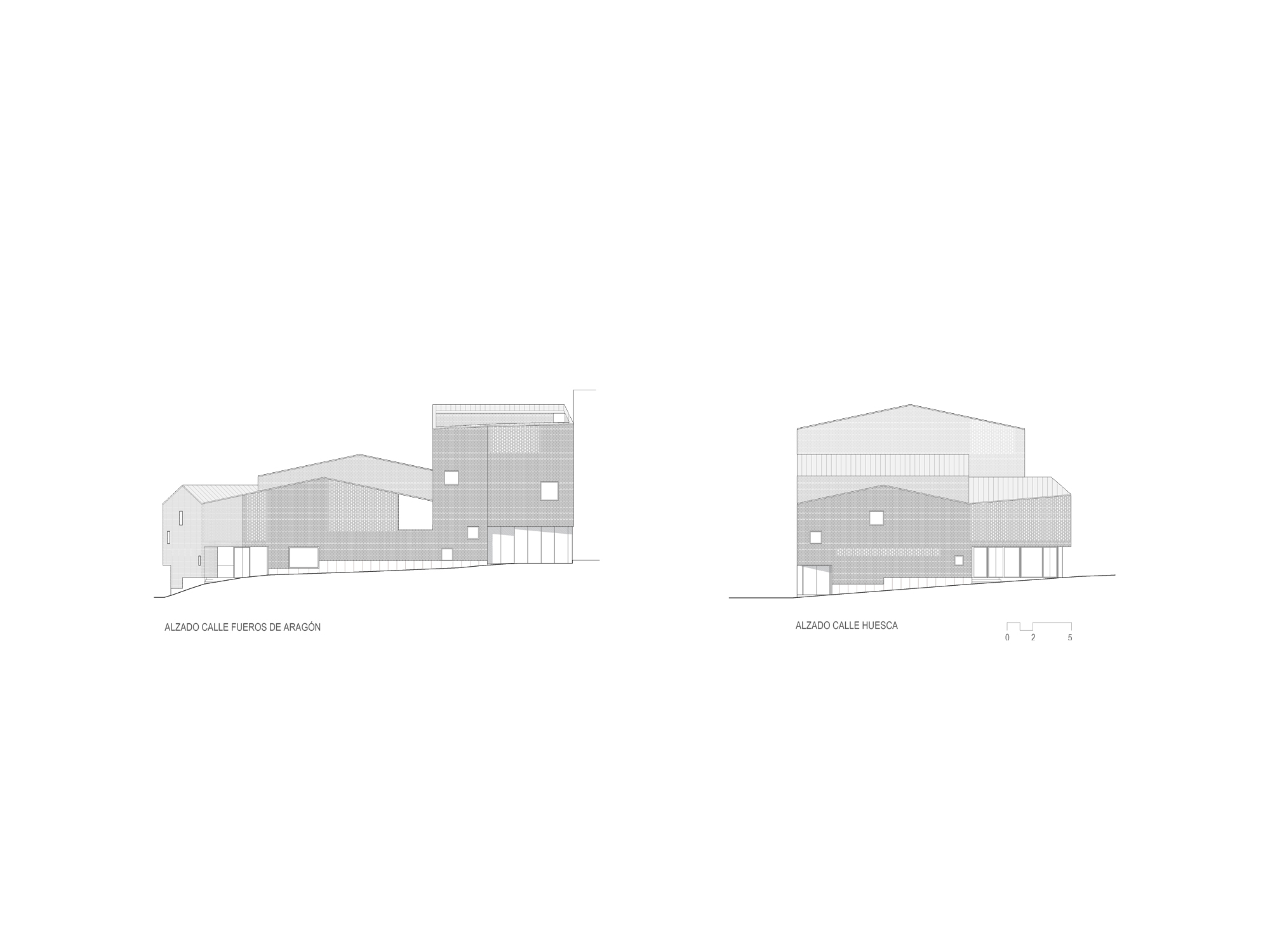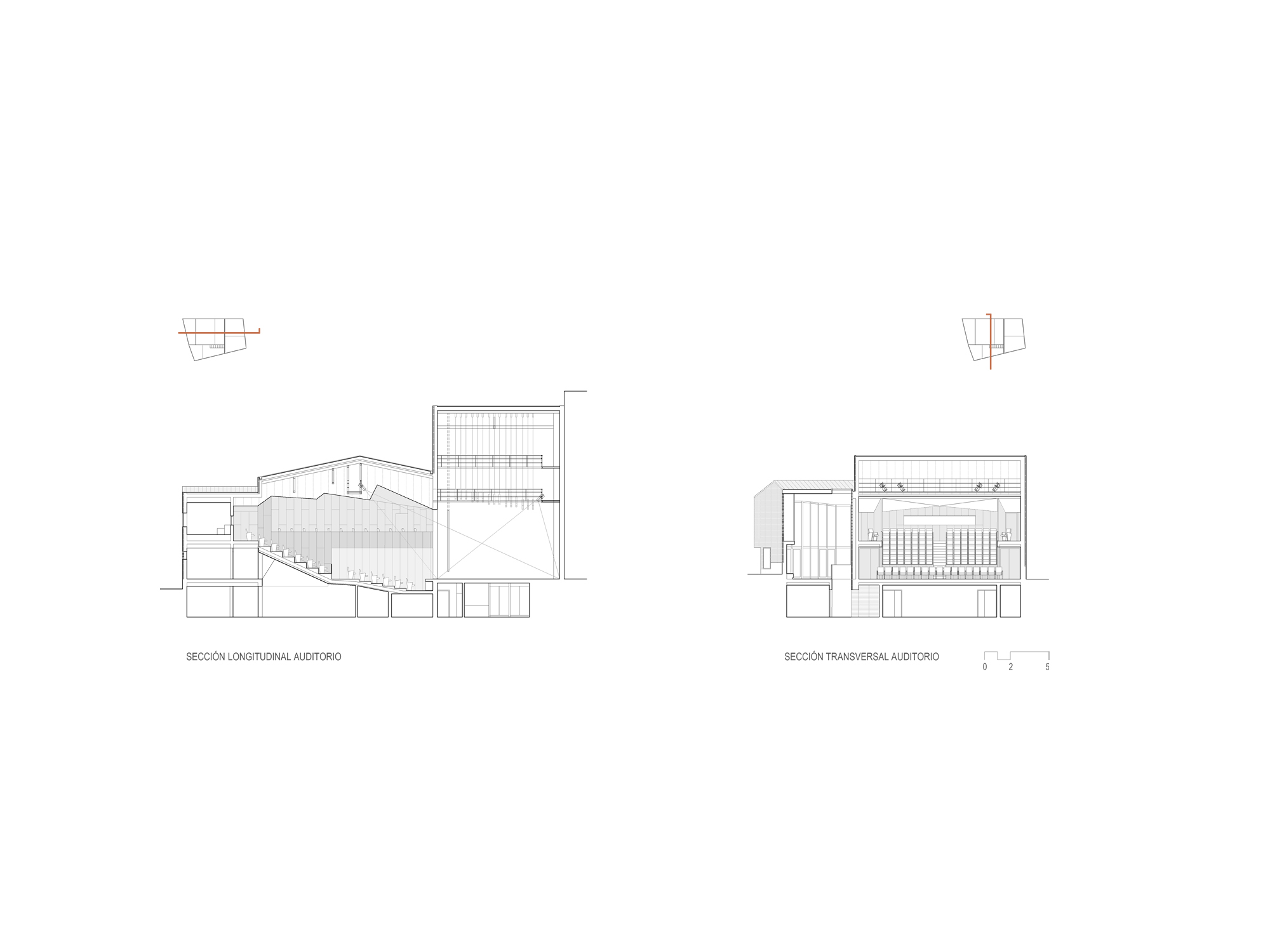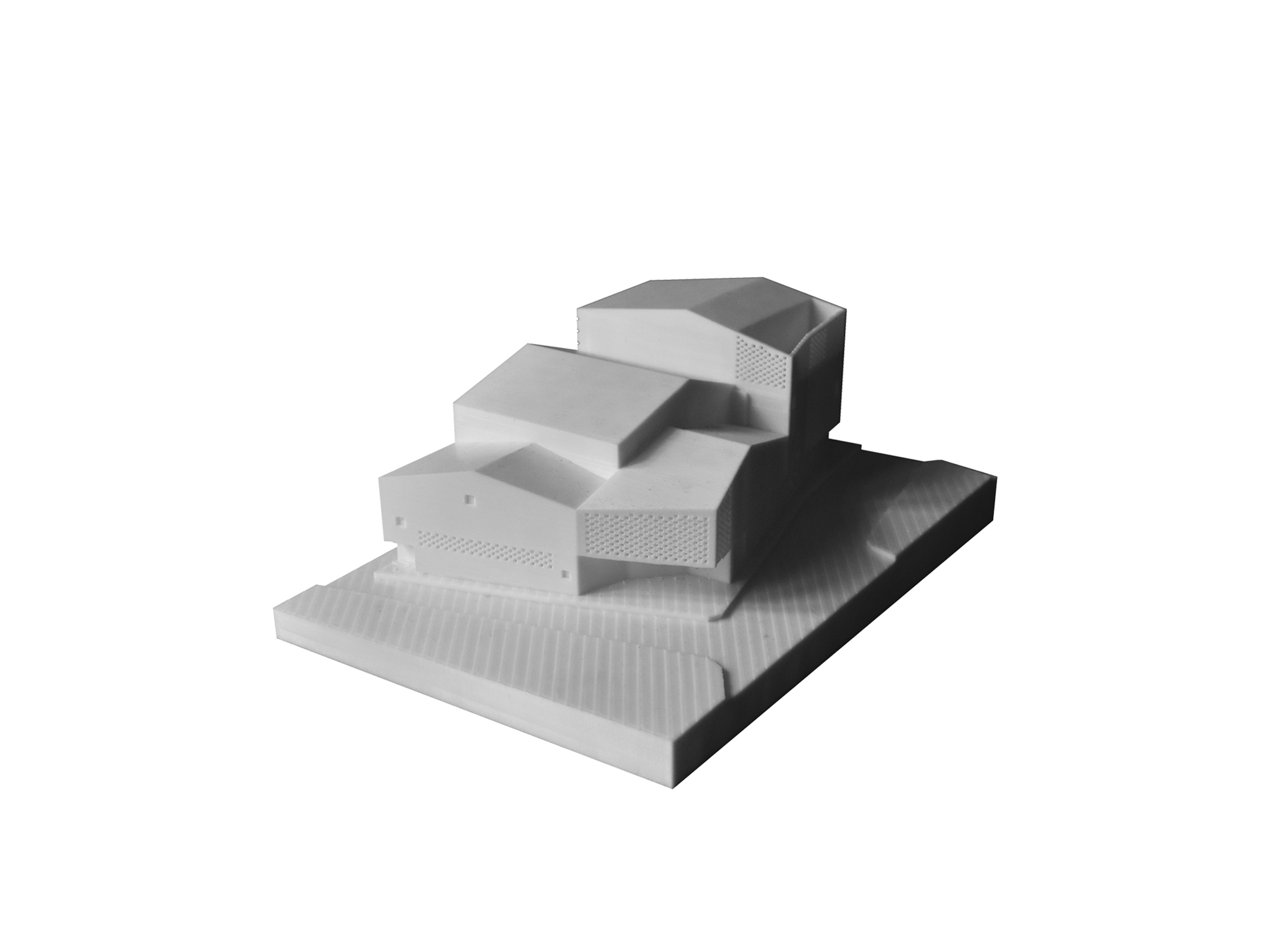Regaining a sense of belonging
Cultural facilities in "Empty Spain"
Theatre-Auditorium and Municipal Music School in the historic center of the village of Illueca.
The construction of the Theatre-Auditorium and the Municipal Music School has played a crucial role in revitalizing the historic center of Illueca and in combating the depopulation that affects many rural areas in Spain. This venue not only provides a space dedicated to cultural and educational activities but has also fostered a sense of community and belonging among residents.
It has attracted visitors interested in the town’s cultural offerings, contributing to the development of the village
It has attracted visitors interested in the town’s cultural offerings, contributing to the development of the village
Spain
Regional
The Aranda district, in the southwest of Aragón, is divided into the councils of: Illueca (capital district), Aranda de Moncayo, Brea de Aragón, Calcena, Gotor, Jarque de Moncayo, Mesones de Isuela, Oseja, Pomer, Purujosa, Sestrica, Tierga, Trasobares and Viver de la Sierra.
Mainly rural
It refers to a physical transformation of the built environment (hard investment)
Yes
2022-10-20
No
No
No
As a representative of an organisation
Project Summary: Recovery of the Sense of Belonging
Overall Aim: Our project breathes new life into Illueca, Zaragoza, through the creation of the new Teatro-Auditorio. Facing rural depopulation, we aim to revitalize the community by embedding a beautiful, sustainable, and inclusive space into the historic town center. This initiative sparks a deep sense of belonging and celebrates the area's rich diversity and traditions.
Target Groups:
Local Residents: People of all ages in Illueca and the Aranda region.
Artists and Cultural Groups: Local talents seeking a vibrant venue.
Visitors and Tourists: Enthusiasts of rural tourism, architecture, and cultural heritage.
Youth: Encouraging younger generations to stay or return.
Specific Objectives:
Combat Depopulation: Offer compelling leisure alternatives to make Illueca more appealing, curbing migration to urban areas.
Architectural Integration: Seamlessly integrate the new structure with historic surroundings by fragmenting it into four volumes echoing local building scales and forms.
Honor Heritage: Use traditional materials like red clinker brick and copper roofing to evoke pottery traditions and blend with neighboring constructions.
Foster Community Engagement: Create spaces promoting intergenerational interaction, serving as a hub for events and cultural exchange.
Enhance Aesthetic Appeal: Complete the urban block without altering the historic skyline, enriching the town's visual continuity and charm.
Achieved Outcomes:
Stunning Venue Completed: A state-of-the-art auditorium seating 224 spectators, featuring innovative continuous tiered seating, inclined planes, and side balconies.
Cultural Revival: Increased local participation in cultural events, energizing the town's artistic scene and showcasing local talent.
Economic Growth: Attracted visitors, stimulating local businesses and fueling Illueca's economy.
Strengthened Identity:Deepened community connection to heritage through architectural elements
Overall Aim: Our project breathes new life into Illueca, Zaragoza, through the creation of the new Teatro-Auditorio. Facing rural depopulation, we aim to revitalize the community by embedding a beautiful, sustainable, and inclusive space into the historic town center. This initiative sparks a deep sense of belonging and celebrates the area's rich diversity and traditions.
Target Groups:
Local Residents: People of all ages in Illueca and the Aranda region.
Artists and Cultural Groups: Local talents seeking a vibrant venue.
Visitors and Tourists: Enthusiasts of rural tourism, architecture, and cultural heritage.
Youth: Encouraging younger generations to stay or return.
Specific Objectives:
Combat Depopulation: Offer compelling leisure alternatives to make Illueca more appealing, curbing migration to urban areas.
Architectural Integration: Seamlessly integrate the new structure with historic surroundings by fragmenting it into four volumes echoing local building scales and forms.
Honor Heritage: Use traditional materials like red clinker brick and copper roofing to evoke pottery traditions and blend with neighboring constructions.
Foster Community Engagement: Create spaces promoting intergenerational interaction, serving as a hub for events and cultural exchange.
Enhance Aesthetic Appeal: Complete the urban block without altering the historic skyline, enriching the town's visual continuity and charm.
Achieved Outcomes:
Stunning Venue Completed: A state-of-the-art auditorium seating 224 spectators, featuring innovative continuous tiered seating, inclined planes, and side balconies.
Cultural Revival: Increased local participation in cultural events, energizing the town's artistic scene and showcasing local talent.
Economic Growth: Attracted visitors, stimulating local businesses and fueling Illueca's economy.
Strengthened Identity:Deepened community connection to heritage through architectural elements
Revitalization
"Empty Spain"
Depopulation
Architectural Integration
Cultural facilities
Our project embodies a comprehensive approach to sustainability, integrating social, economic, and environmental dimensions to revitalize Illueca, a town in the "Empty Spain" ("La España vacía") region facing depopulation challenges.
Social Sustainability: The Teatro-Auditorio serves as a beacon for community cohesion, providing a dynamic space that fosters cultural engagement and social interaction. By hosting performances and being the headquarters of the municipal music school, it offers opportunities for education and artistic expression. The building acts as a catalyst in combating depopulation by enhancing quality of life and strengthening the sense of belonging among residents.
Economic Sustainability: Economically, the project stimulates regional development by attracting visitors, cultural practitioners, and tourists, which boosts local businesses and services. The venue creates jobs and promotes the cultural sector, diversifying the local economy. By enhancing Illueca’s appeal as a cultural destination, it contributes to the sustainable economic growth of the region.
Environmental Sustainability: Environmentally, the building is thoughtfully integrated into its historical context, respecting the scale and aesthetics of the existing urban fabric. The design employs sustainable materials like red clinker brick and copper roofing, which evoke local traditions while offering durability and thermal efficiency. Energy-efficient installations, such as optimized HVAC systems and natural lighting solutions reduce the building's carbon footprint.
By harmonizing these sustainability pillars, the Teatro-Auditorio of Illueca not only revitalizes a community in the "Empty Spain" but also sets a precedent for holistic sustainable development. It exemplifies how architecture can be a powerful tool in addressing social challenges, promoting onomic vitality, and respect ng environmental imperatives, ultimately crafting a resilient future for local communities.
Social Sustainability: The Teatro-Auditorio serves as a beacon for community cohesion, providing a dynamic space that fosters cultural engagement and social interaction. By hosting performances and being the headquarters of the municipal music school, it offers opportunities for education and artistic expression. The building acts as a catalyst in combating depopulation by enhancing quality of life and strengthening the sense of belonging among residents.
Economic Sustainability: Economically, the project stimulates regional development by attracting visitors, cultural practitioners, and tourists, which boosts local businesses and services. The venue creates jobs and promotes the cultural sector, diversifying the local economy. By enhancing Illueca’s appeal as a cultural destination, it contributes to the sustainable economic growth of the region.
Environmental Sustainability: Environmentally, the building is thoughtfully integrated into its historical context, respecting the scale and aesthetics of the existing urban fabric. The design employs sustainable materials like red clinker brick and copper roofing, which evoke local traditions while offering durability and thermal efficiency. Energy-efficient installations, such as optimized HVAC systems and natural lighting solutions reduce the building's carbon footprint.
By harmonizing these sustainability pillars, the Teatro-Auditorio of Illueca not only revitalizes a community in the "Empty Spain" but also sets a precedent for holistic sustainable development. It exemplifies how architecture can be a powerful tool in addressing social challenges, promoting onomic vitality, and respect ng environmental imperatives, ultimately crafting a resilient future for local communities.
Our project—the new Teatro-Auditorio in Illueca—aims to revitalize this historic town through design that deeply resonates with people, enhancing both aesthetics and cultural experience.
Key Objectives and Achievements:
Seamless Architectural Integration:
Objective: Harmoniously meld the auditorium into Illueca's historic setting, respecting local scale and aesthetics.
Achievement: Deconstructed the building into four volumes with gabled roofs of varying heights and orientations, mirroring the organic arrangement of local homes and blending effortlessly with the urban fabric. The design respects the irregular topography, creating a natural flow that's both fresh and familiar.
Celebrating Local Heritage:
Objective: Honor Illueca's rich cultural traditions and instill pride among residents.
Achievement: Utilized materials rooted in local heritage—red clinker brick and copper roofing—that echo the town's pottery traditions and native red sandstone hues. Thoughtful use of brick in lattices, patterns, and acoustic elements showcases craftsmanship and connects to regional history, creating a dialogue between past and present.
Enhancing the Human Experience:
Objective: Create inviting spaces that stimulate the senses and promote meaningful interactions.
Achievement: Natural light filters through ceramic lattices, casting dynamic patterns that enliven interiors. Strategic voids and openings link the volumes, fostering exploration and connection. Wooden-framed windows offer curated views of historic surroundings, grounding visitors. Innovative seating—with gently sloped stalls, inclined planes, and side balconies—provides diverse perspectives, making performances engaging and intimate.
Fostering Cultural and Social Vitality:
Objective: Use architecture as a catalyst for community engagement and enrichment.
Achievement: Beyond a performance venue, it houses the municipal music school, becoming a vibrant hub for education and creativity. The design encourages flui
Key Objectives and Achievements:
Seamless Architectural Integration:
Objective: Harmoniously meld the auditorium into Illueca's historic setting, respecting local scale and aesthetics.
Achievement: Deconstructed the building into four volumes with gabled roofs of varying heights and orientations, mirroring the organic arrangement of local homes and blending effortlessly with the urban fabric. The design respects the irregular topography, creating a natural flow that's both fresh and familiar.
Celebrating Local Heritage:
Objective: Honor Illueca's rich cultural traditions and instill pride among residents.
Achievement: Utilized materials rooted in local heritage—red clinker brick and copper roofing—that echo the town's pottery traditions and native red sandstone hues. Thoughtful use of brick in lattices, patterns, and acoustic elements showcases craftsmanship and connects to regional history, creating a dialogue between past and present.
Enhancing the Human Experience:
Objective: Create inviting spaces that stimulate the senses and promote meaningful interactions.
Achievement: Natural light filters through ceramic lattices, casting dynamic patterns that enliven interiors. Strategic voids and openings link the volumes, fostering exploration and connection. Wooden-framed windows offer curated views of historic surroundings, grounding visitors. Innovative seating—with gently sloped stalls, inclined planes, and side balconies—provides diverse perspectives, making performances engaging and intimate.
Fostering Cultural and Social Vitality:
Objective: Use architecture as a catalyst for community engagement and enrichment.
Achievement: Beyond a performance venue, it houses the municipal music school, becoming a vibrant hub for education and creativity. The design encourages flui
Our project—the new Teatro-Auditorio in Illueca—puts inclusion at its heart, aiming to make culture accessible and meaningful for everyone. We created a space that welcomes all, fostering new models of social interaction
Key Objectives and How We've Met Them:
Universal Accessibility:
Objective: Ensure full accessibility for people of all abilities. Achievement: Designed barrier-free access throughout the venue with ramps, elevators, and seating arrangements accommodating wheelchair users and those with mobility challenges. Implemented clear signage and tactile elements for the visually impaired, making navigation intuitive for all.
Affordability and Community Engagement:
Objective: Make cultural experiences affordable and encourage widespread participation. Achievement: As a publicly funded space, we offer free or low-cost events, workshops, and performances. Hosting the municipal music school within the building provides educational opportunities for youth.
Inclusive Governance:
Objective: Involve community members in decision-making processes. Achievement: Established a governing board that includes local residents, artists, and stakeholders, ensuring shape programming and use of the space. This participatory approach empowers the community and aligns the auditorium's offerings with their needs.
Design for All Principles:
Objective: Create a space usable by everyone, promoting social cohesion. Achievement: Incorporated open, interconnected spaces that encourage spontaneous interactions across all ages and backgrounds.
Combating Depopulation:
Objective: Use the project to revitalize rural areas facing depopulation. Achievement: Provided a vibrant cultural hub, making Illueca more attractive for residents and newcomers. The auditorium serves as a prototype for revitalizing the ""Empty Spain," demonstrating how inclusive infrastructure can reverse depopulation trends. In essence, the project is a community catalyst embodying inclusion at every level
Key Objectives and How We've Met Them:
Universal Accessibility:
Objective: Ensure full accessibility for people of all abilities. Achievement: Designed barrier-free access throughout the venue with ramps, elevators, and seating arrangements accommodating wheelchair users and those with mobility challenges. Implemented clear signage and tactile elements for the visually impaired, making navigation intuitive for all.
Affordability and Community Engagement:
Objective: Make cultural experiences affordable and encourage widespread participation. Achievement: As a publicly funded space, we offer free or low-cost events, workshops, and performances. Hosting the municipal music school within the building provides educational opportunities for youth.
Inclusive Governance:
Objective: Involve community members in decision-making processes. Achievement: Established a governing board that includes local residents, artists, and stakeholders, ensuring shape programming and use of the space. This participatory approach empowers the community and aligns the auditorium's offerings with their needs.
Design for All Principles:
Objective: Create a space usable by everyone, promoting social cohesion. Achievement: Incorporated open, interconnected spaces that encourage spontaneous interactions across all ages and backgrounds.
Combating Depopulation:
Objective: Use the project to revitalize rural areas facing depopulation. Achievement: Provided a vibrant cultural hub, making Illueca more attractive for residents and newcomers. The auditorium serves as a prototype for revitalizing the ""Empty Spain," demonstrating how inclusive infrastructure can reverse depopulation trends. In essence, the project is a community catalyst embodying inclusion at every level
The Auditorium and music school in Illueca was conceived with a deep connection to the community it serves, aiming to create a space that reflects the town's cultural heritage and addresses the needs of its residents. While specific records of citizen involvement may not be extensively documented, the project's alignment with local traditions and its role in the community suggest meaningful engagement with citizens and civil society throughout its development.
Role and Level of Involvement:
Community Consultations:
Feedback Gathering: Efforts were made to understand the desires and concerns of Illueca's residents. Through meetings and informal discussions, the project team likely sought input on the auditorium's functions.
Integration of Local Institutions: The project was promoted by the town council of Illueca, with significant financial support from the provincial council.
Municipal Music School: By housing the municipal music school within the auditorium, educators, students, and families were inherently involved.
Collaboration with Local Artisans:
Utilization of Traditional Materials: The choice to use red clinker brick and incorporate craftsmanship reflects collaboration with local artisans. This not only supports local employment but also ensures that the building resonates with the community's identity.
Engagement with Cultural Groups:
Cultural Programming: Local artists and cultural organizations likely participated in planning the types of events and programs the auditorium would host, ensuring it meets the diverse cultural interests of the town.
Impact of This Involvement:
Enhanced Relevance and Acceptance;
Strengthened Community Ownership; Social Cohesion;Economic Boost; Educational Enrichment.
The project's success is partially rooted in its connection to the people of Illueca. By considering local needs, traditions, and aspirations, the Teatro-Auditorio became more than just a building—it evolved into a centerpiece of community life.
Role and Level of Involvement:
Community Consultations:
Feedback Gathering: Efforts were made to understand the desires and concerns of Illueca's residents. Through meetings and informal discussions, the project team likely sought input on the auditorium's functions.
Integration of Local Institutions: The project was promoted by the town council of Illueca, with significant financial support from the provincial council.
Municipal Music School: By housing the municipal music school within the auditorium, educators, students, and families were inherently involved.
Collaboration with Local Artisans:
Utilization of Traditional Materials: The choice to use red clinker brick and incorporate craftsmanship reflects collaboration with local artisans. This not only supports local employment but also ensures that the building resonates with the community's identity.
Engagement with Cultural Groups:
Cultural Programming: Local artists and cultural organizations likely participated in planning the types of events and programs the auditorium would host, ensuring it meets the diverse cultural interests of the town.
Impact of This Involvement:
Enhanced Relevance and Acceptance;
Strengthened Community Ownership; Social Cohesion;Economic Boost; Educational Enrichment.
The project's success is partially rooted in its connection to the people of Illueca. By considering local needs, traditions, and aspirations, the Teatro-Auditorio became more than just a building—it evolved into a centerpiece of community life.
The Teatro-Auditorio in Illueca is a testament to collaborative efforts between local and regional stakeholders, resulting in a project that revitalizes the community and addresses regional challenges.
Local Level:
Town Council of Illueca:
Role and Involvement: As the primary promoter, the town council initiated and oversaw the project's development. Recognizing the need to combat depopulation and enhance cultural infrastructure, they led planning, coordination, and community engagement efforts.
Added Value: Their leadership ensured the project aligned with local needs and aspirations. By driving the initiative, they fostered a sense of ownership and pride among residents, making the auditorium a true community asset.
Local Residents and Community Groups:
Role and Involvement: Citizens participated through consultations, public meetings, and feedback sessions, influencing the design and functionality of the auditorium. Local artists, educators, and cultural organizations contributed ideas for programming and use.
Regional Level: Provincial Council
Role and Involvement: Provided significant financial support through subsidies, partnering with the town council to secure necessary funding for the project.
Added Value: This collaboration bridged financial gaps, enabling the realization of a high-quality facility.
It demonstrated regional commitment to supporting rural development and cultural initiatives.
The Teatro-Auditorio of Illueca exemplifies effective stakeholder engagement at local and regional levels. The town council's initiative, supported by the provincial council's subsidies and shaped by community input, led to a facility that not only enhances cultural offerings but also addresses broader social challenges. This collaborative model highlights the significant added value derived from involving stakeholders at various levels, resulting in a project deeply rooted in community needs and contributing to the region's revitalization.
Local Level:
Town Council of Illueca:
Role and Involvement: As the primary promoter, the town council initiated and oversaw the project's development. Recognizing the need to combat depopulation and enhance cultural infrastructure, they led planning, coordination, and community engagement efforts.
Added Value: Their leadership ensured the project aligned with local needs and aspirations. By driving the initiative, they fostered a sense of ownership and pride among residents, making the auditorium a true community asset.
Local Residents and Community Groups:
Role and Involvement: Citizens participated through consultations, public meetings, and feedback sessions, influencing the design and functionality of the auditorium. Local artists, educators, and cultural organizations contributed ideas for programming and use.
Regional Level: Provincial Council
Role and Involvement: Provided significant financial support through subsidies, partnering with the town council to secure necessary funding for the project.
Added Value: This collaboration bridged financial gaps, enabling the realization of a high-quality facility.
It demonstrated regional commitment to supporting rural development and cultural initiatives.
The Teatro-Auditorio of Illueca exemplifies effective stakeholder engagement at local and regional levels. The town council's initiative, supported by the provincial council's subsidies and shaped by community input, led to a facility that not only enhances cultural offerings but also addresses broader social challenges. This collaborative model highlights the significant added value derived from involving stakeholders at various levels, resulting in a project deeply rooted in community needs and contributing to the region's revitalization.
The Teatro-Auditorio in Illueca is a significant example of how a multitude of disciplines can come together to create something truly special. The project's success is rooted in the dynamic collaboration between various knowledge fields, each contributing unique insights to design and implementation.
1. Architecture and Urban Planning
Architects led the design process, focusing on integrating the new auditorium seamlessly into Illueca's historic fabric.
Urban Planners assessed the building's impact on the town's layout and ensured it complemented the existing urban environment.
2. Engineering (Structural, Civil, Environmental)
Structural Engineers addressed the technical aspects of constructing on irregular topography.
Environmental Engineers implemented sustainability measures and energy-efficient systems.
Collaborated with architects to integrate sustainable features without compromising design. Worked with environmental scientists to minimize the building's ecological footprint.
3. Acoustic Engineering and Performing Arts
Acoustic Engineers ensured optimal sound quality within the auditorium.
Performing Arts Specialists advised on space requirements for performances.
Worked with architects on interior design for acoustics.
Collaborated with the municipal music school to meet functional needs.
4. Education and Cultural Programming
Educators from the municipal music school influenced the design to accommodate educational activities.
Provided input on classroom spaces and rehearsal areas. Assisted in planning cultural programming for the community.
This collaborative approach not only enhanced the building's design and functionality but also strengthened the community's social fabric. By bridging architecture, culture, engineering, social sciences, and more, we've created a space that resonates on multiple levels. It's an example of how multidisciplinary collaboration can lead to innovative, meaningful, and impactful projects that leave a legacy.
1. Architecture and Urban Planning
Architects led the design process, focusing on integrating the new auditorium seamlessly into Illueca's historic fabric.
Urban Planners assessed the building's impact on the town's layout and ensured it complemented the existing urban environment.
2. Engineering (Structural, Civil, Environmental)
Structural Engineers addressed the technical aspects of constructing on irregular topography.
Environmental Engineers implemented sustainability measures and energy-efficient systems.
Collaborated with architects to integrate sustainable features without compromising design. Worked with environmental scientists to minimize the building's ecological footprint.
3. Acoustic Engineering and Performing Arts
Acoustic Engineers ensured optimal sound quality within the auditorium.
Performing Arts Specialists advised on space requirements for performances.
Worked with architects on interior design for acoustics.
Collaborated with the municipal music school to meet functional needs.
4. Education and Cultural Programming
Educators from the municipal music school influenced the design to accommodate educational activities.
Provided input on classroom spaces and rehearsal areas. Assisted in planning cultural programming for the community.
This collaborative approach not only enhanced the building's design and functionality but also strengthened the community's social fabric. By bridging architecture, culture, engineering, social sciences, and more, we've created a space that resonates on multiple levels. It's an example of how multidisciplinary collaboration can lead to innovative, meaningful, and impactful projects that leave a legacy.
The Illueca Teatro-Auditorio stands out for its innovative character, challenging traditional practices in architectural design and community development in rural settings.
1.Fusion of Tradition and Modernity: While many rural projects either preserve historical structures or introduce modern designs that sharply contrast with their surroundings, this auditorium achieves a harmonious integration of both. It is deconstructed into four volumes with gabled roofs reflecting local residential forms, reducing its scale and respecting traditional aesthetics. The innovative use of materials like red clinker brick and copper roofing—employed in contemporary ways through lattices and patterns—connects the past with the present.
2.Combating Depopulation through Culture: Instead of focusing solely on economic incentives or basic infrastructure, the project uses culture as a revitalizing axis. By housing the auditorium and serving as the headquarters of the municipal music school, it places culture at the heart of community revitalization, enhancing quality of life and attracting residents and visitors.
3.Participatory and Inclusive Design: The project is promoted by the Illueca Town Council with subsidies from the Provincial Council, actively involving the community.
4.Multidisciplinary Collaboration: Integrating various disciplines—architecture, history, engineering, sociology, and local craftsmanship—resulted in innovative solutions that balance aesthetics, functionality, and sustainability.
5.Cultural and Environmental Sustainability: Beyond standard sustainable practices, the project incorporates cultural sustainability by using local materials and artisanal techniques that support the regional economy and preserve heritage.
6. Prototype for Rural Revitalization: It serves as a model for other rural areas facing depopulation ("Empty Spain"), , demonstrating that investment in cultural infrastructure can generate significant social and economic benefits.
1.Fusion of Tradition and Modernity: While many rural projects either preserve historical structures or introduce modern designs that sharply contrast with their surroundings, this auditorium achieves a harmonious integration of both. It is deconstructed into four volumes with gabled roofs reflecting local residential forms, reducing its scale and respecting traditional aesthetics. The innovative use of materials like red clinker brick and copper roofing—employed in contemporary ways through lattices and patterns—connects the past with the present.
2.Combating Depopulation through Culture: Instead of focusing solely on economic incentives or basic infrastructure, the project uses culture as a revitalizing axis. By housing the auditorium and serving as the headquarters of the municipal music school, it places culture at the heart of community revitalization, enhancing quality of life and attracting residents and visitors.
3.Participatory and Inclusive Design: The project is promoted by the Illueca Town Council with subsidies from the Provincial Council, actively involving the community.
4.Multidisciplinary Collaboration: Integrating various disciplines—architecture, history, engineering, sociology, and local craftsmanship—resulted in innovative solutions that balance aesthetics, functionality, and sustainability.
5.Cultural and Environmental Sustainability: Beyond standard sustainable practices, the project incorporates cultural sustainability by using local materials and artisanal techniques that support the regional economy and preserve heritage.
6. Prototype for Rural Revitalization: It serves as a model for other rural areas facing depopulation ("Empty Spain"), , demonstrating that investment in cultural infrastructure can generate significant social and economic benefits.
The Illueca Teatro-Auditorio project adopted a holistic and participatory methodology that diverges from mainstream practices by deeply integrating community engagement, interdisciplinary collaboration, and sensitive contextual design. This approach resulted in a cultural facility that not only serves functional needs but also revitalizes the social, economic, and environmental fabric of a rural town facing depopulation.
Key Methodological Innovations:
Community-Centered Design: Actively involved local residents, artists, educators, and authorities from the outset through workshops and consultations. This participatory process ensured the building reflects the community's needs, cultural identity, and aspirations, fostering a sense of ownership and enhancing acceptance and sustainability.
Interdisciplinary Collaboration: Unified architects, engineers, historians, sociologists, environmental scientists, and local artisans into a cohesive team.
Contextual and Adaptive Design: Emphasized harmonious integration with the historic environment by deconstructing the building into four volumes with gabled roofs reflecting local architectural forms, creating a design both contemporary and deeply connected to its context.
Cultural Revitalization Focus: Positioned architecture as a catalyst for social change by embedding cultural facilities like the municipal music school within the building. This approach stimulates cultural activity, fosters intergenerational interaction, and combats depopulation by enhancing quality of life.
Use of Local Materials and Craftsmanship: Incorporated materials like red clinker brick and copper roofing, involving local artisans to meld traditional techniques with modern design.
Sustainability Integration: Embedded sustainability at every stage, from design to implementation, including energy-efficient systems, natural lighting, and ventilation strategies.
Key Methodological Innovations:
Community-Centered Design: Actively involved local residents, artists, educators, and authorities from the outset through workshops and consultations. This participatory process ensured the building reflects the community's needs, cultural identity, and aspirations, fostering a sense of ownership and enhancing acceptance and sustainability.
Interdisciplinary Collaboration: Unified architects, engineers, historians, sociologists, environmental scientists, and local artisans into a cohesive team.
Contextual and Adaptive Design: Emphasized harmonious integration with the historic environment by deconstructing the building into four volumes with gabled roofs reflecting local architectural forms, creating a design both contemporary and deeply connected to its context.
Cultural Revitalization Focus: Positioned architecture as a catalyst for social change by embedding cultural facilities like the municipal music school within the building. This approach stimulates cultural activity, fosters intergenerational interaction, and combats depopulation by enhancing quality of life.
Use of Local Materials and Craftsmanship: Incorporated materials like red clinker brick and copper roofing, involving local artisans to meld traditional techniques with modern design.
Sustainability Integration: Embedded sustainability at every stage, from design to implementation, including energy-efficient systems, natural lighting, and ventilation strategies.
The Illueca Teatro-Auditorio project embodies several elements that are highly transferable and replicable to other locations, beneficiary groups, and contexts. These include methodologies, processes, design approaches, and valuable insights that can inspire similar initiatives elsewhere.
Community-Centered Design Approach: Actively involving local communities in design and implementation ensures that projects resonate with the people's needs and aspirations. This participatory method fosters ownership and sustainability and can be adopted by any community-driven project aiming to enhance relevance and engagement.
Cultural Revitalization through Architecture: Leveraging architecture to preserve and celebrate local heritage while meeting contemporary needs strengthens community identity and pride. Other towns can integrate cultural elements into new developments, fostering a sense of belonging and continuity.
Use of Local Materials and Craftsmanship: Employing locally sourced materials and involving local artisans supports regional economies and ensures new structures harmonize with their environments.
Addressing Rural Challenges with Cultural Infrastructure: Utilizing cultural facilities to combat rural depopulation by enhancing attractiveness and livability offers a strategic alternative to conventional economic incentives. Rural communities worldwide can adopt this strategy to stimulate social and economic revitalization.
Multidisciplinary Collaboration: Bringing together professionals from various fields leads to holistic solutions.
Contextual and Adaptive Design: Designing buildings that respond to specific contexts—including including topography, climate, and cultural settings—enhances harmony between new developments and their surroundings.
Sustainability Integration: Embedding environmental sustainability into design and implementation reduces environmental impacts and promotes resource efficiency.
Community-Centered Design Approach: Actively involving local communities in design and implementation ensures that projects resonate with the people's needs and aspirations. This participatory method fosters ownership and sustainability and can be adopted by any community-driven project aiming to enhance relevance and engagement.
Cultural Revitalization through Architecture: Leveraging architecture to preserve and celebrate local heritage while meeting contemporary needs strengthens community identity and pride. Other towns can integrate cultural elements into new developments, fostering a sense of belonging and continuity.
Use of Local Materials and Craftsmanship: Employing locally sourced materials and involving local artisans supports regional economies and ensures new structures harmonize with their environments.
Addressing Rural Challenges with Cultural Infrastructure: Utilizing cultural facilities to combat rural depopulation by enhancing attractiveness and livability offers a strategic alternative to conventional economic incentives. Rural communities worldwide can adopt this strategy to stimulate social and economic revitalization.
Multidisciplinary Collaboration: Bringing together professionals from various fields leads to holistic solutions.
Contextual and Adaptive Design: Designing buildings that respond to specific contexts—including including topography, climate, and cultural settings—enhances harmony between new developments and their surroundings.
Sustainability Integration: Embedding environmental sustainability into design and implementation reduces environmental impacts and promotes resource efficiency.
The Illueca Teatro-Auditorio is more than just a building; it's a beacon of how local initiatives can tackle global challenges head-on. By focusing on cultural revitalization, social cohesion, economic sustainability, and environmental stewardship, the project offers insightful solutions to issues faced worldwide.
The Illueca Teatro-Auditorio exemplifies how local solutions can effectively address significant global challenges:
Combating depopulation by enhancing quality of life and providing opportunities within the community.
Preserving cultural heritage through architecture that reflects and celebrates local traditions.
Strengthening social cohesion by creating inclusive spaces that foster community interaction.
Stimulating economic growth by boosting local businesses and attracting tourism.
Promoting environmental sustainability with eco-friendly design and local materials.
Ensuring equitable access to cultural and educational resources.
Supporting local economies in the global marketplace.
By placing the community's needs and identity at the forefront, the project not only revitalizes Illueca but also offers a replicable model for other regions facing similar challenges. It demonstrates that when local initiatives are thoughtfully designed and inclusive, they can make meaningful contributions to resolving global issues.
The Teatro-Auditorio invites us to rethink how we approach development—celebrating the unique characteristics of each community while addressing universal concerns. It's a powerful reminder that real, impactful change often begins at home, inspiring others to harness local strengths to create a better world.
The Illueca Teatro-Auditorio exemplifies how local solutions can effectively address significant global challenges:
Combating depopulation by enhancing quality of life and providing opportunities within the community.
Preserving cultural heritage through architecture that reflects and celebrates local traditions.
Strengthening social cohesion by creating inclusive spaces that foster community interaction.
Stimulating economic growth by boosting local businesses and attracting tourism.
Promoting environmental sustainability with eco-friendly design and local materials.
Ensuring equitable access to cultural and educational resources.
Supporting local economies in the global marketplace.
By placing the community's needs and identity at the forefront, the project not only revitalizes Illueca but also offers a replicable model for other regions facing similar challenges. It demonstrates that when local initiatives are thoughtfully designed and inclusive, they can make meaningful contributions to resolving global issues.
The Teatro-Auditorio invites us to rethink how we approach development—celebrating the unique characteristics of each community while addressing universal concerns. It's a powerful reminder that real, impactful change often begins at home, inspiring others to harness local strengths to create a better world.
The Illueca Teatro-Auditorio has significantly contributed to the "Recovery of the Sense of Belonging" by revitalizing the cultural life of the area through concrete and impactful outcomes.
Results and Outcomes:
Operational Music School:Two Years of Operation: For the past two years, the municipal music school has been fully functional within the auditorium. Educational Impact: It offers music education to local students, fostering talent and engaging youth in cultural activities.
Increased Cultural Events:
Concerts: The venue has hosted numerous concerts featuring local and regional musicians, enriching the community's musical landscape. These events have provided platforms for artists and delighted audiences with a variety of musical genres.
Theatrical Performances: A diverse array of theater plays has been staged, supporting performing arts and offering residents access to live theater previously unavailable locally.
Film Screenings: Regular cinema showings have been introduced, bringing national and international films to the community. This has broadened entertainment options and provided cultural insights through the medium of film.
Revitalized Cultural Life:
Significant Increase in Events: With a bustling schedule of concerts, plays, and film screenings, the auditorium has become a vibrant cultural hub. The frequency and variety of events have markedly increased compared to previous years.
Community Engagement: These activities have attracted attendees from Illueca and neighboring towns, fostering social interaction and strengthening community bonds. The auditorium has become a meeting point where people gather to share experiences.
Enhanced Quality of Life: Residents now have local access to diverse cultural experiences that enhance daily life and community pride. This convenience has reduced the need to travel to larger cities for such events.
The project's concrete achievements demonstrate its effectiveness in restoring a sense of belonging.
Results and Outcomes:
Operational Music School:Two Years of Operation: For the past two years, the municipal music school has been fully functional within the auditorium. Educational Impact: It offers music education to local students, fostering talent and engaging youth in cultural activities.
Increased Cultural Events:
Concerts: The venue has hosted numerous concerts featuring local and regional musicians, enriching the community's musical landscape. These events have provided platforms for artists and delighted audiences with a variety of musical genres.
Theatrical Performances: A diverse array of theater plays has been staged, supporting performing arts and offering residents access to live theater previously unavailable locally.
Film Screenings: Regular cinema showings have been introduced, bringing national and international films to the community. This has broadened entertainment options and provided cultural insights through the medium of film.
Revitalized Cultural Life:
Significant Increase in Events: With a bustling schedule of concerts, plays, and film screenings, the auditorium has become a vibrant cultural hub. The frequency and variety of events have markedly increased compared to previous years.
Community Engagement: These activities have attracted attendees from Illueca and neighboring towns, fostering social interaction and strengthening community bonds. The auditorium has become a meeting point where people gather to share experiences.
Enhanced Quality of Life: Residents now have local access to diverse cultural experiences that enhance daily life and community pride. This convenience has reduced the need to travel to larger cities for such events.
The project's concrete achievements demonstrate its effectiveness in restoring a sense of belonging.

